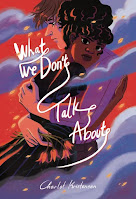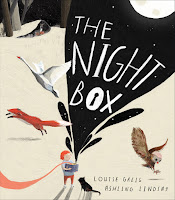This reading adventure began, as many do, with recommendations. The startling thing is that I followed through and read the book at all. In my life as an English teacher, I’ve learned that books are many, time is short, and during the school year I will get no reading done (unless forced). TJ Klune’s The House in the Cerulean Sea started popping up all over the place on Instagram first – and not just around its release date, but a swell of love and support over many months. That was fine, and I noticed it, but it didn’t prompt me to take action. Then I showed up to my book club’s Zoom meeting a couple of months ago and it was personally recommended by long-time reading friends. Their arguments were persuasive – I purchased the book then and there! And only 2ish months later, I read it all in one day. The House in the Cerulean Sea delivered on its promised cozy vibes, and reading it was a nice way to slide into summer mode.
Linus Baker leads a quiet, solitary life. At forty, he lives in a tiny house with a devious cat and his old records. As a Case Worker at the Department in Charge of Magical Youth, he spends his days overseeing the well-being of children in government-sanctioned orphanages.
When Linus is unexpectedly summoned by Extremely Upper Management he's given a curious and highly classified assignment: travel to Marsyas Island Orphanage, where six dangerous children reside: a gnome, a sprite, a wyvern, an unidentifiable green blob, a were-Pomeranian, and the Antichrist. Linus must set aside his fears and determine whether or not they’re likely to bring about the end of days.
But the children aren’t the only secret the island keeps. Their caretaker is the charming and enigmatic Arthur Parnassus, who will do anything to keep his wards safe. As Arthur and Linus grow closer, long-held secrets are exposed, and Linus must make a choice: destroy a home or watch the world burn.
An enchanting story, masterfully told, The House in the Cerulean Sea is about the profound experience of discovering an unlikely family in an unexpected place—and realizing that family is yours.
The House in the Cerulean Sea is the story of Linus Baker, a government worker in a fictional (and nominally magical) world who is desperately lonely, but keeps himself too busy fulfilling his job according to the draconian Rules and Regulations to think very deeply about his dissatisfaction with his life. The only bits of happiness he has are the sunflowers in his garden, his cat Calliope, and his record collection. Linus’ internal monologue is immediately hilarious, but his life overall is sad and dreary. This metaphor is extended even further in tragicomic fashion: Linus constantly misses the bus (or it is late), forgets his umbrella on rainy days, and engages in light self-hatred (about his weight), along with holding a seeming life-long goal of blending in with the wall paint. Luckily, the business of the book is to make him happy. Author Klune accomplishes this by delving into the fantasy portion of the novel, when Linus must make an unusual casework visit to a whimsical island and observe the family who live there. Over the course of his visit, Linus (or Mr. Baker, as he goes by at the orphanage he is “investigating”) slowly develops his capacity for happiness, and by the end of the book all’s well that ends well.
What I knew going into reading the book: magical house/school, cozy vibes, quiet read, LGBTQ+ characters. What I got in the first several chapters: an absolutely miserable main character in an awful desk job that gave me flashbacks to some of my own worst working experiences. Let’s just say there was some whiplash between expectations and reality. I almost put the book down about 5 times in the first 5 chapters. I kept going because of the promised payoff from the recommendations of others. So, with that off my chest, I can say… this book IS lovely in many ways, as is Linus, but they both require a bit of patience from the reader to uncover their strengths and treasures.
Author Klune’s task in this novel is a complex and delicate one: to start with a character that the reader can immediately identify as unhappy, unambitious, and with low self-esteem, and expose them to a combination of plot and character elements that will thoroughly change their outlook on life, actions, and future, all without seeming “out of character.” It is a masterful character study, but it doesn’t feel contrived – it instead is a story suffused with homey, magical details, and I think that is why it is so beloved.
So, that’s the book. I think it was successful on its own merits, and a feat of engineering! And obviously, cozy vibes and quiet reads are nothing to shake a stick at. BUT DID I ENJOY IT??? That is a tough question, and one I’ve been asking myself over and over again in the last 12 hours or so since I finished the book. And I think the answer is, to use one of my favorite words, complex. On one hand: yes. I can appreciate the underpinnings that make this book art, and I appreciate the aura of it all, and of course I love magical stories. But one thing about being in the head of a character with such low self-esteem, and such a dreary outlook on life, is that is hard not to get trapped in the emotional transference. Other people in the book kept telling Linus he was worthy and delightful, and yet… on his side, he couldn’t see it. And thus, in a way, the reader (or at least THIS reader) couldn’t see it. As I said, complex. I feel satisfied that I didn’t waste my time reading the book, but it’s not a favorite, or even a “keep it on my shelf” book. It’ll go live instead in my classroom library at school!
I do appreciate LGBTQ+ characters getting to live everyday lives, and being the centers of cozy books. I also appreciated that, while the book is marketed to adults, it will be very popular with younger readers and those who read YA and crossover titles. Because of the novel’s focus on children’s lives and children’s well-being through Linus’ line of work, the feel is quite innocent and light, even when it deals with heavier themes and subject matter like prejudice and child abuse.
In all, a perfectly satisfactory summer read, and one for when you need a dash of whimsy and warmth in your life.
Recommended for: fans of Katherine Addison’s books (especially The Angel of the Crows, which I read and also enjoyed in a complex way last summer), those who enjoy quiet fantasy with hints of Diana Wynne Jones and/or Robin McKinley, and anyone who wants to see more LGBTQ+ representation in science fiction and fantasy!



















